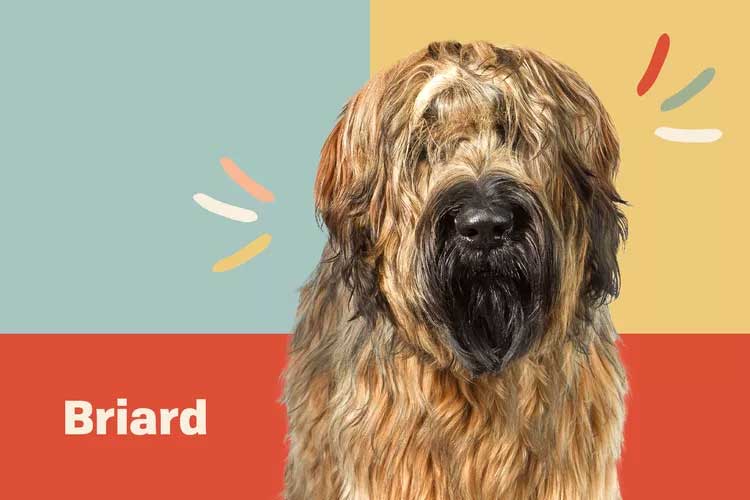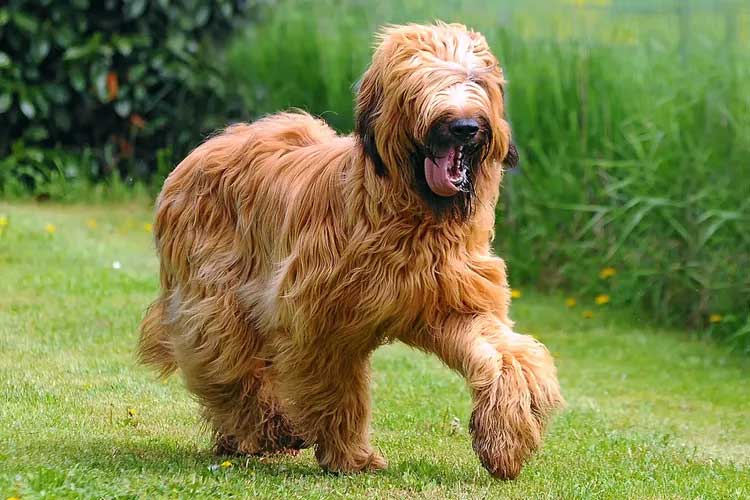Briards are active dogs that will win your affection with their work ethic and rugged good looks. These large, long-haired dogs are loyal, affectionate, and confident.

Briard Overview
| OFFICIAL NAME | Briard |
| COMMON NAME | Briard |
| PET HEIGHT | 22 to 27 inches |
| PET WEIGHT | 55 to 100 pounds |
| LIFESPAN | 12 to 12 years |
| GOOD WITH | children, families |
| TEMPERAMENT | friendly, outgoing |
| INTELLIGENCE | high |
| SHEDDING AMOUNT | infrequent |
| EXERCISE NEEDS | high |
| ENERGY LEVEL | active |
| VOCAL LEVEL | when necessary |
| DROOL AMOUNT | low |
| BREED GROUP | herding |
| BREED SIZE | large (61-100 lbs.) |
| COAT LENGTH | long |
| COLORS | black, fawn, gray |
| PATTERNS | bicolor |
| OTHER TRAITS | cold weather tolerant, good hiking companion, strong loyalty tendencies, tolerates being alone |
Dating all the way back to the eighth century, briards were the courageous, agile, intelligent flock guardians French farmers prized. They won over their humans with their boundless energy and strong work ethic, but it didn't take long for their rugged good looks, unwavering loyalty, and affectionate natures to make them popular companions today.
Appearance
When you have a briard at the end of your leash, you have a dog that's quite the head-turner. His long, waving locks give him a slightly scruffy (and utterly adorable) appearance."The briard, to me, is a beautiful and fit-looking dog with a very intelligent expression—even with all the hair coming down on [his] face," says Sonya Hillier, rescue and puppy coordinator for the British Briard Club.

Briards are large dogs that reach up to 27 inches tall and weigh between 55–100 pounds. Their coats are their most distinctive features. The briard has a fine undercoat and coarse, hard outercoat that lies flat in three colors: black, tawny, or black and grey. Their hair is longer on their heads, forming a natural (and trendy) center part that frames their dark eyes. On their other end is a well-feathered tail that's ready to wag at the first mention of walkies.
Temperament
Traits including confidence, courage, and intelligence allowed briards to excel as working dogs, but their sweet spirits, affectionate natures, and boundless loyalty have helped the breed become popular companions, too.Hillier has been raising briards since the 1990s and cites their temperament as a key reason she fell in love with the breed, adding, "The briard's personality is gay and lively, very loyal, and would rather be with you wherever you go. They can also be real characters and make you laugh."
Thanks to their history as farmhands, briards like to have jobs to do. If there are no pastures to roam and flocks to guard, these dogs will require a lot of exercise to burn off their physical—and mental—energy.

Because of his history as a herder and guardian, extra care must be taken to properly socialize a briard puppy. While the breed develops strong bonds with his family, socialization can help him feel more comfortable around strangers.
"Briards must be trained and socialized with people and animals from a puppy stage," Hillier says.
Living Needs
You don't need a flock of goats or cattle to keep briards happy. In fact, Hillier says, "briards can generally live in most types of accommodations."Briards are active dogs so a home with a fenced yard, access to a dog park, or plenty of long walks is ideal. The breed does well with children and other dogs as long as he's been properly socialized and trained.
However, their working instinct remains strong, which means briards might bark at unfamiliar sights and sounds. If you live in an apartment or other space with shared walls, this might lead to some not-so-happy neighbors.
Care
Regular exercise is important for briards. They love long walks, hiking trails, and swimming, and they'll also happily play fetch or tug-of-war in the backyard. Briards also do well in obedience, agility, tracking, herding, and other dog sports.Training is important, too. These independent working dogs excel at making decisions solo and might take a while to train. But briards are smart and can learn basic commands and new tricks with a little encouragement and positive reinforcement—using treats won't hurt, either!
"For a first-time briard owner, the dog will surprise you once in a while and do something you did not teach [him to do], but it shows just how smart they are and how much they love to please you," Hillier says.
Like training, maintaining a briard's coat requires dedication. Hillier suggests establishing a grooming routine when briards are puppies. Their soft, fluffy baby coats may not need much attention, but as their coarse, adult coats come in, regular grooming is essential. The earlier you start grooming your briard, the easier it will be to continue the habit.

Brush your briard at least once a week to remove dead hair and prevent tangles. You might need to brush them more often during the spring and fall, but overall they don't shed much. More good news: briards rarely need baths.
"The adult briard coat should be coarse, so with regular brushing it should not need bathing often unless [he's] dirty," Hillier says.
A good grooming routine also includes regular nail trims, ear cleanings, and dental care like at-home brushing and professional cleanings.
Health
Briards have a lifespan of 12 years. And though Hillier notes he's "overall a healthy breed," there are a few common health conditions to note.Hip dysplasia: Some briards develop hip dysplasia, a condition that occurs when the hip joint and socket don't fit quite right, leading to a painful grinding in the joint. Hip dysplasia is a degenerative disease with no cure, but it can often be managed with physical therapy and anti-inflammatory medications. Surgery may also be necessary.
Ear infections: Briards may be at higher risk of ear infections because his floppy ear shape and long hair tends to trap moisture, allowing bacteria and yeast to develop. Prevention is essential: Dry a briard's ears thoroughly after a bath or swimming, and ask your veterinarian for tips on regular ear cleaning.
Bloat: Like other large breeds, briards are at increased risk for gastric dilatation volvulus or GDV, also known as bloat. The condition occurs when gas stretches the stomach and causes it to twist. Bloat can be life-threatening. A procedure called a gastropexy, which involves stitching the stomach to the side of the body, is often recommended as a preventive measure for high risk breeds like the briard. Talk to your veterinarian about how to prevent GDV.
History
Briards hail from France where the breed is known as Chien Berger de Brie.French farmers, in need of agile, courageous, intelligent dogs to guard their flocks of sheep, goats, and cattle, developed the briard in the eighth century, according to the Briard Club of America. The dogs have been working as guardians in the dairy-producing region of France (and around the world) ever since.
By the 1800s, about 1,000 years after the breed was developed, briards became wildly popular in France. The pups were even named the official dog of the French Army.
"This breed is so versatile," Hillier says. "They were used in the first World War; they pulled carts with first aid or ammunition. They were even messenger dogs and were really amazing at finding the wounded soldiers on the battlefield amongst the dead and saving so many lives."
Thomas Jefferson brought the first briard to the United States in 1789. He purchased the dog, named Bergere, when he was the ambassador to France and brought the pregnant pup back to Monticello. These dogs formed the foundation of the breed in the U.S.
The briard's good looks and affable personalities have made him a longtime favorite breed in France and around the world. The American Kennel Club recognized the breed in 1928.
Fun Facts
The briard is a popular breed on the big and small screens, appearing in the Chuck Norris film Top Dog, Married…with Children, Dennis the Menace, and Buddy.A briard named Norman holds the world record for the fastest 30 meters on a scooter by a dog. He completed the course in 20.77 seconds in 2013.
In 2015, Colonial Williamsburg named two briards, Liberty and Justice, as its official mascots. They were reenactors that played George Washington's dogs.